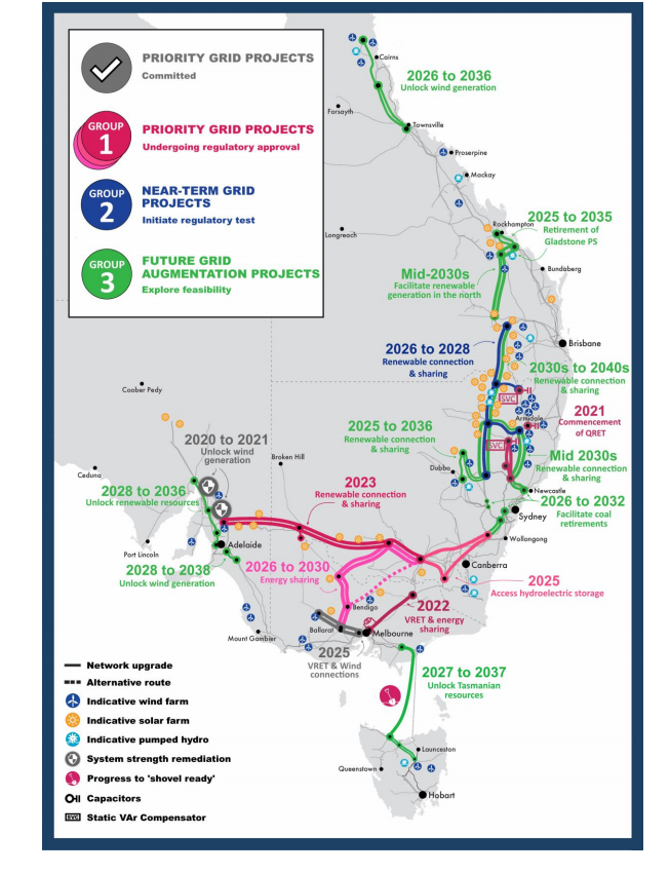What’s new in ISP II?
The Australian Energy Market Operator (AEMO) has released the 2020 Draft Integrated System Plan (ISP).
The ISP looks to chart a secure, reliable and low-cost pathway for the development of the grid as our electricity generation sector transforms to a low emissions future.
Ageing coal-fired generation is retiring and levels of variable renewable generation are rapidly increasing.
The 2020 ISP builds upon and updates the 2018 ISP.
From mid-2020, the development of the ISP will be a regulated requirement under the national electricity rules.
Out with the old and in with the new
Existing generation capacity in the National Electricity Market (NEM) is about 54,000MW[i].
By 2030, 8,640MW of coal-fired generation is expected to retire, and by 2040 it will be about 29,000MW[ii].
New generation capacity will include variable renewable energy in the form of wind and large-scale solar, pumped hydro and small-scale batteries (virtual power plants).
The new generation will not in the same area as the retiring coal plants. This change means that the new generation will require additional transmission capacity to enable the power to reach customers in cities and towns where the energy is consumed.
For every 1 MW of coal generation retiring, about 2-3 MW of new renewable generation capacity will be needed in the central scenario AEMO modelled[iii]. The difference reflects that variable renewable energy will not operate all the time.
What is in the draft 2020 ISP?
After extensive modelling considering a ‘least regrets’ approach that is robust under a range of future scenarios, the draft ISP selects an optimal development path as outlined in Figure 1[i].

Figure 1 – Development Path in the Draft 2020 ISP[ii]
What’s changed?
Table 1 outlines the high priority, medium-term and longer-term projects in the 2018 ISP and maps them to the same projects in the draft 2020 ISP.
So what has changed?
- The 2020 draft ISP has more high priority projects. This shift is because some of the 2018 projects have moved from medium-term to high priority and are progressing through the regulatory investment test and the revenue adjustment approval processes.
- The federal government announced the go-ahead on Snowy2.0. Given this additional generation capacity, the transmission lines going north and south are needed, i.e. Humelink and VNIWest (formerly Kerang link) are now included as high priority.
- The draft ISP considers that Project EnergyConnect, the proposed interconnector between SA and NSW, is committed, however this project, while progressing, still needs approval from the AER to adjust the regulated revenue to fund the project.
- Project Marinus, the second interconnector between Tasmania and Victoria, has moved from monitoring to shovel-ready status in the recent draft ISP. The implementation timeframe is uncertain and spans a decade and will be reassessed in the 2022 and 2024 ISP. The benefits of Marinus are National Energy Market (NEM) wide, so fairer cost recovery needs to be introduced for this project to proceed.
| 2018 ISP | 2020 Draft ISP | Where is the project up to? | Indicative Timing | |
| High priority, Group 1
(implement ASAP) |
VNI (minor) | VNI (minor) | PADR published, Aug 19 | 2022-23 |
| QNI (minor) | QNI (minor) | Revenue adjustment sought from AER | 2021-2022 | |
| Western Vic | Western Vic | Revenue adjustment no approval needed | 2025-26 | |
| System Strength SA | System Strength SA | Revenue adjustment approved by AER | 2020-21 to 2021-22 | |
| Medium-term, Group 2
(implement by mid-20s)
|
Riverlink (SA -NSW interconnector)
SA-Vic (minor) |
EnergyConnect | RIT-T approved by AER, revenue adjustment not commenced | 2023-2024 |
| QNI (medium) | RIT-T not started | 2026-27 to 2028-29 | ||
| Coordinate DER in SA | Market bodies working on policy | |||
| Monitor need for SnowyLinks north and south and Marinus depending on Snowy2.0 and Battery of the Nation decisions | Humelink (SnowyLink north) | PADR published, Jan 20 | 2024-2025 | |
| VNIWest
(SnowyLink south or KerangLink) |
PSCR published, Dec 2019 | 2026-27 to 2028-29 | ||
| Marinus – shovel ready not an actionable ISP project | PADR published, Dec 2019 | 2023-24 (shovel ready)
2026-27-2036-37 |
||
| Longer-term, Group 3
(implement in the ’30s) |
Within state transmission work to connect renewables | Not actionable, the further assessment required
Qld and NSW grid reinforcements Network to support renewable energy zones |
||
Table 1: Mapping of 2018 ISP to 2020 Draft ISP and project status
COAG
The Council of Australian Governments (COAG) Energy Council is heavily involved in ‘actioning’ the ISP. The 20 March meeting will be asked to approve new rules to establish the ISP as part of the regulatory framework. It will also look at:
- fairer cost-sharing arrangements for transmission investments;
- actions to progress renewable energy zone connections; and
- a review of the NEM reliability standard.
Busy times indeed.
[i] AEMO Generation Information Page, 31 Jan 2020, summary sheet
[ii] AEMO ISP 2020-Scenario Comparison Central, retirements sheet
[iii] Draft 2020 ISP generation Outlooks, AEMO ISP 2020-Scenario Comparison_Central, capacity 1 sheet
[iv] Priority projects considered “committed” in the draft ISP may not be “committed” as defined in the Final RIT-T, June 2010, paragraph 18. For a transmission project to be considered in the Regulatory test for transmission, five criteria need to be met.
[v] AEMO, Draft 2020 Integrated system plan, Fig 1, p 20

